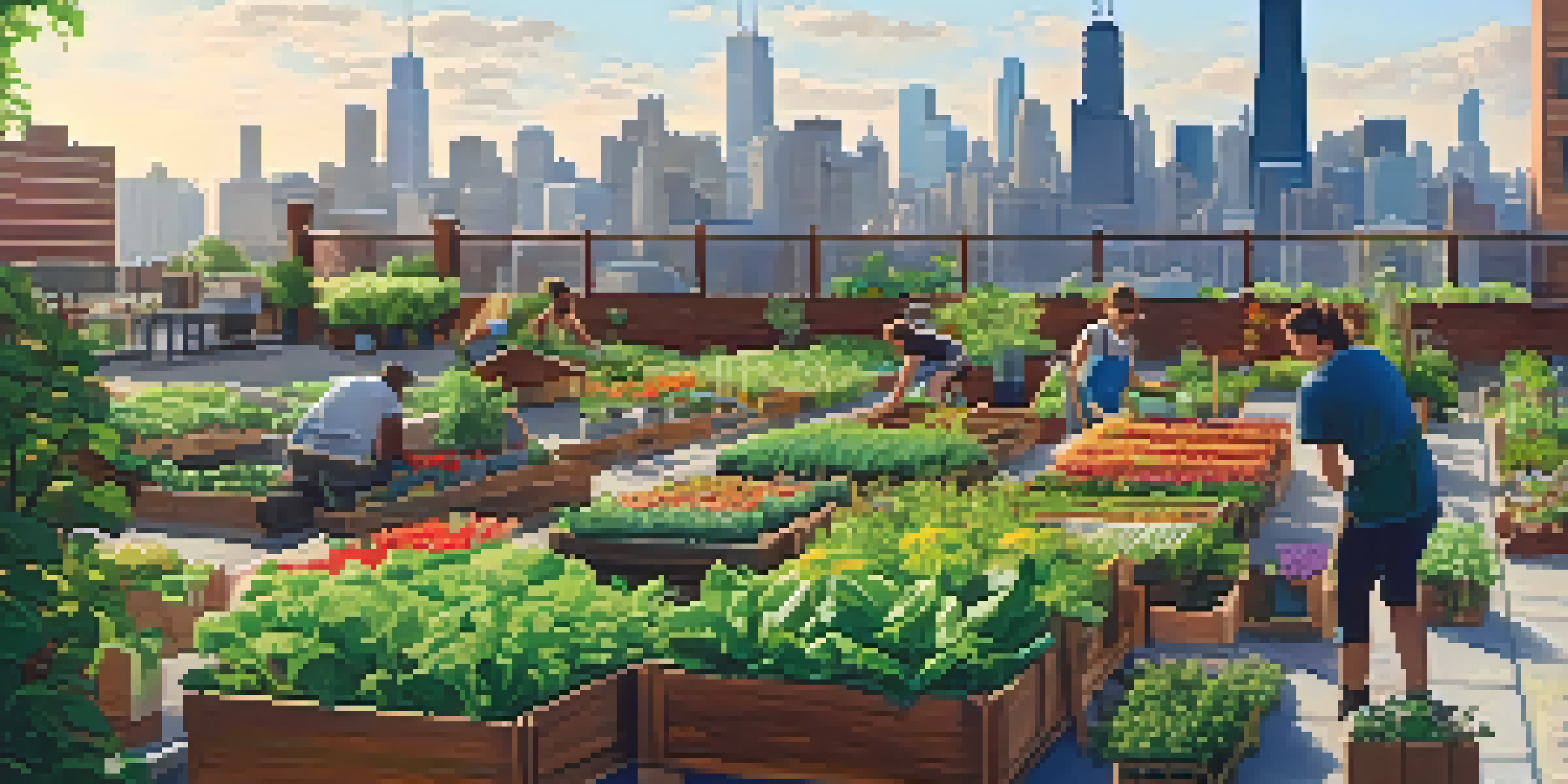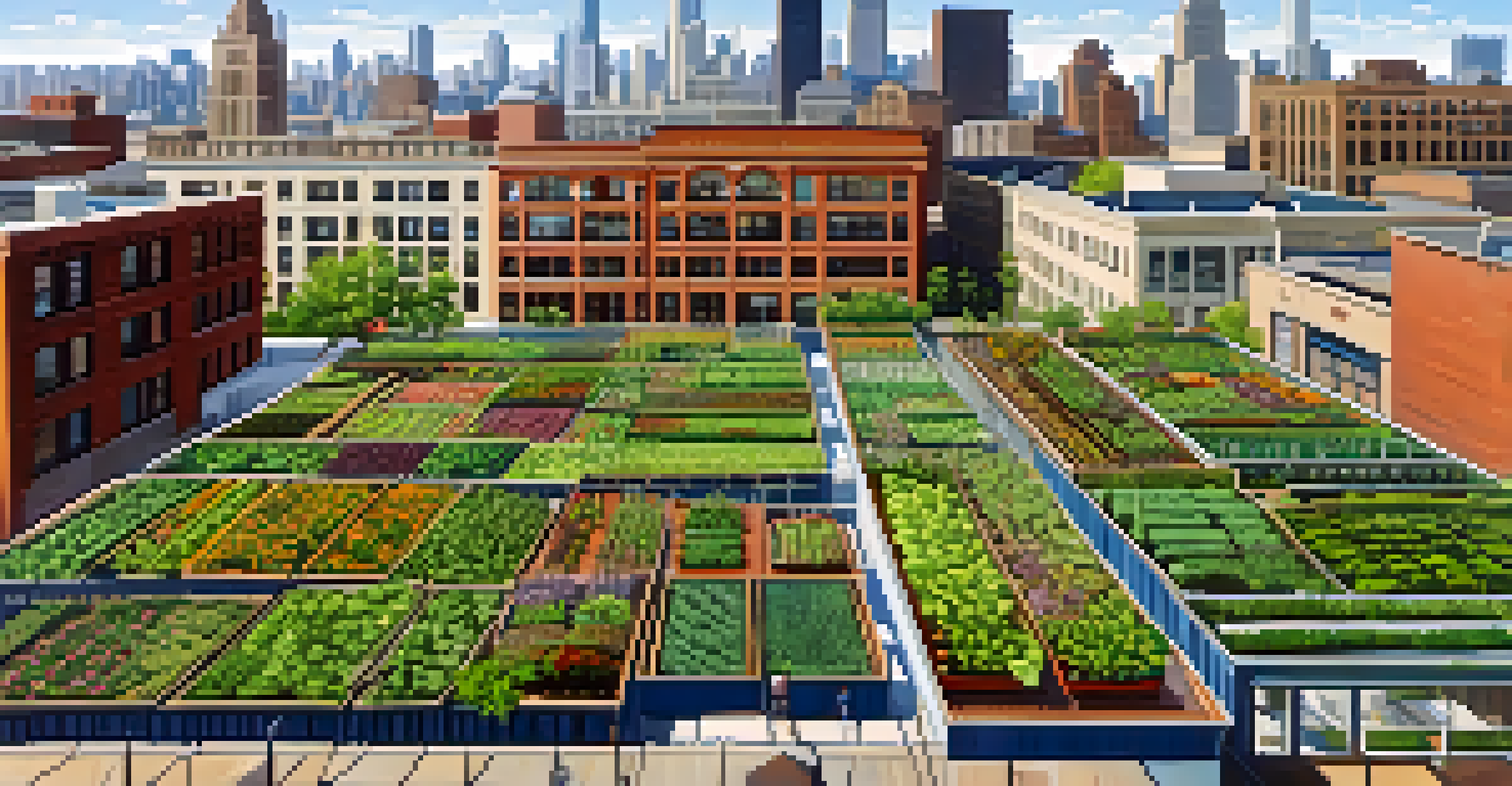Chicago's Rooftop Farms: Greening the Urban Landscape

The Rise of Rooftop Farming in Chicago
In recent years, Chicago has seen a surge in rooftop farming, a movement that is transforming the urban landscape. With limited space in the city, these rooftop farms maximize unused areas, allowing locals to grow fresh produce right above their heads. This trend not only helps in producing food but also promotes sustainability by reducing the carbon footprint associated with transporting food from rural areas.
Urban agriculture is a way to connect people with their food, foster community, and promote sustainability in our cities.
Rooftop farms are more than just a fad; they represent a significant shift in how urban dwellers think about food production. As people become more aware of where their food comes from, the demand for locally sourced ingredients has increased. Rooftop farms cater to this demand while providing a unique opportunity for city residents to engage in agriculture.
Additionally, these farms contribute to the local economy by creating jobs and supporting small businesses. As more rooftop farms open, they often collaborate with local restaurants and markets, further embedding themselves into the fabric of the community.
Environmental Benefits of Rooftop Farms
Rooftop farms play a crucial role in enhancing the urban ecosystem. They provide habitats for pollinators, such as bees and butterflies, which are essential for maintaining biodiversity in cities. By planting a variety of crops and flowers, these farms can help create a more vibrant and balanced urban environment.

Moreover, rooftop farms help combat the urban heat island effect, a phenomenon where cities become significantly warmer than surrounding areas. The greenery of these farms acts as natural insulation, cooling buildings and reducing energy costs. This is especially important in a city like Chicago, where summer temperatures can soar.
Rooftop Farms Boost Urban Sustainability
These farms utilize unused city spaces to grow fresh produce, significantly reducing carbon footprints and promoting local food production.
Water management is another critical benefit of rooftop farms. They can absorb rainwater, which reduces runoff and the risk of flooding in urban areas. This sustainable approach to water management is essential as climate change continues to impact weather patterns.
Community Engagement Through Urban Agriculture
Rooftop farms foster a sense of community by bringing people together over a shared love for gardening and sustainability. Many of these farms offer workshops, volunteer days, and community events that invite residents to participate in the farming process. This engagement helps to build connections among neighbors and encourages a collective commitment to environmental stewardship.
Rooftop gardens are an innovative solution to enhance urban biodiversity and mitigate climate change while producing food.
Local schools often partner with rooftop farms to educate students about agriculture and nutrition. By providing hands-on learning experiences, these farms help cultivate a new generation of environmentally conscious individuals. Students learn about the importance of local food systems and how to grow their own food, empowering them to make healthier choices.
Additionally, community-supported agriculture (CSA) programs are frequently integrated into rooftop farms. By allowing residents to subscribe for regular deliveries of fresh produce, these programs strengthen the bond between urban farmers and the community, ensuring that everyone has access to healthy food.
Challenges Facing Rooftop Farmers
Despite the many benefits, rooftop farming does come with its challenges. One significant hurdle is the initial cost of setting up a farm, including the necessary infrastructure and soil systems. For many aspiring rooftop farmers, securing funding or sponsorship can be a daunting task, limiting the number of successful ventures.
Weather conditions can also pose challenges for rooftop farms. High winds, extreme temperatures, and unpredictable rainfall can impact crop yields. Farmers need to carefully plan and adapt their strategies to ensure the success of their crops throughout the changing seasons.
Community Engagement Through Farming
Rooftop farms foster community connections by offering workshops and programs that educate residents about gardening and sustainable practices.
Additionally, zoning regulations and building codes can complicate the establishment of rooftop farms. Navigating these legal frameworks requires patience and persistence, but many farmers are finding creative solutions to overcome these obstacles, demonstrating the resilience of the urban farming movement.
Innovative Techniques in Rooftop Agriculture
To address the challenges of rooftop farming, many urban farmers are turning to innovative techniques. Hydroponics and aquaponics are popular methods that allow crops to grow in nutrient-rich water instead of traditional soil. These systems are particularly effective in limited spaces and can yield faster results, making them ideal for urban environments.
Vertical farming is another approach gaining traction in Chicago’s rooftop scene. By stacking layers of crops, farmers can maximize their growing area while minimizing the amount of land needed. This technique not only increases productivity but also creates a visually appealing green space in the city skyline.
Technology also plays a vital role in modern rooftop farming. Automated systems for watering, monitoring plant health, and managing nutrients can help farmers optimize their operations. By leveraging technology, rooftop farms can become more efficient and sustainable, paving the way for the future of urban agriculture.
Rooftop Farms and Local Food Security
Rooftop farms are an essential component of local food security efforts in Chicago. By producing fresh and nutritious food close to where it is consumed, these farms help reduce the reliance on food imports and long supply chains. This is particularly important in urban areas where access to fresh produce can be limited.
Moreover, rooftop farms contribute to the resilience of food systems by diversifying local food sources. In times of crisis, such as during the COVID-19 pandemic, having local food production can mitigate disruptions in the supply chain and ensure communities have access to essential resources.
Innovative Solutions for Urban Farming
Techniques like hydroponics and vertical farming are helping rooftop farmers overcome challenges and maximize productivity in limited urban spaces.
Supporting rooftop farms also encourages consumers to buy locally, which helps strengthen the local economy. When residents invest in their community's food systems, they not only enjoy fresher produce but also contribute to a more sustainable and self-reliant urban environment.
Future of Rooftop Farms in Chicago
The future of rooftop farms in Chicago looks promising as more residents and businesses recognize their value. With increasing awareness about sustainability and food security, it's likely that we will see further expansion and innovation in this sector. As urban areas continue to grow, the need for green spaces will become even more critical.
City policies are also evolving to support the rooftop farming movement. Initiatives that incentivize green building practices and urban agriculture can help remove barriers for farmers and encourage more rooftop projects. Collaborations between local government, non-profits, and community organizations are essential in shaping the future of urban agriculture.

As Chicago embraces this green revolution, rooftop farms will play a vital role in enhancing the quality of life for its residents. By transforming underutilized spaces into flourishing gardens, these farms not only beautify the city but also contribute to a healthier and more sustainable urban future.